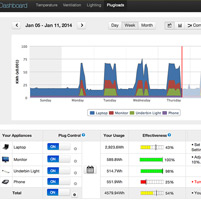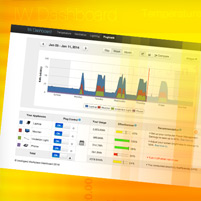Plugged In

Click above to view larger image

Ray Yun, a doctoral student in the School of Architecture at Carnegie Mellon University, has developed a dashboard that shows office workers how much energy their plugged-in devices are consuming.
By providing building occupants with visual feedback of their energy use and an online ability to control plug loads at each desk, Yun and a team from the Center for Building Performance and Diagnostics (CBPD) are showing the potential to save energy nationwide.
Buildings consume about 40 percent of all energy used in the United States and about 70 percent of the nation's electricity.
"What I am most proud of is helping people see energy-saving opportunities," Yun said. "Office workers have no big incentive to put any effort into conserving energy at work, since they don't pay the bills. Without providing rewards or penalties or forcing workers to use our dashboard, we have successfully assisted them in voluntarily acting on behalf of the environment."
The Intelligent Dashboard for Occupants is being field tested by 80 employees at a Fortune 500 company. Office occupants are testing variables such as online communication, consultation and control supported by plug-in devices that measure the energy consumption of their electronics and provide the ability to turn off items digitally.
After six weeks, all of the groups saw energy savings. The group with immediate energy use readings, online control and the ability to control their work on a calendar cut their plug load energy consumption by more than a third.
"Energy dashboards for plug load savings in the workplace are critical to saving electricity in a nation scrambling to produce electricity without environmental damage," said Vivian Loftness, a University Professor and former head of the School of Architecture. She said small changes can make a difference.
"There are so many things we can do as individuals, but we haven't been empowered or informed. The Intelligent Dashboard is about empowering the building's occupants to achieve positive change," Loftness said.
The team's work has received international attention. The Wall Street Journal published an article last September, and the dashboard has been presented to audiences in Australia, Singapore and Switzerland and soon Canada and Greece.
"There is a lot of interest in the importance of managing plug loads and providing ways for office workers to play a role in reducing unnecessary energy usage," Loftness said.
Loftness is one of the more than 100 CMU faculty working together across disciplines to solve the world's toughest energy challenges through the university's Wilton E. Scott Institute for Energy Innovation.
The CBPD is housed in The Robert L. Preger Intelligent Workplace. Yun's research team includes Loftness, Azizan Aziz, Bertrand Lasternas, Peter Scupelli, Chenlu Zhang, Yunjeong Mo and Jie Zhao.
Related Links: WSJ: Energy Dashboards Enter the Office Cubicle | Scott Institute for Energy Innovation | Center for Building Performance and Diagnostics | School of Architecture
